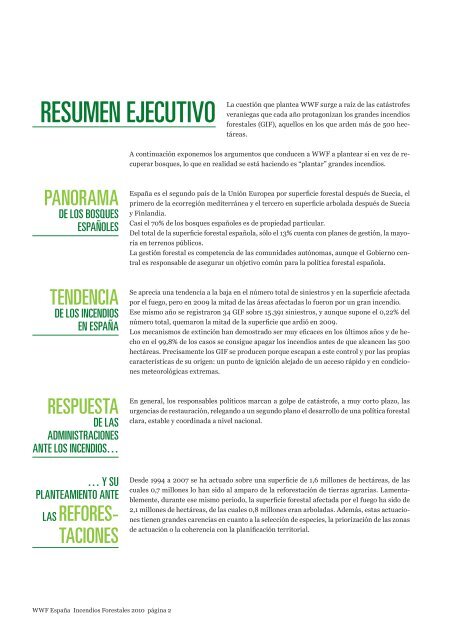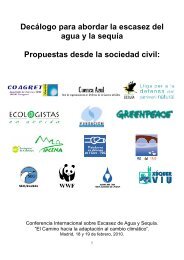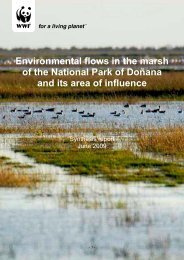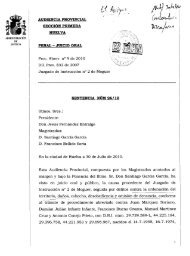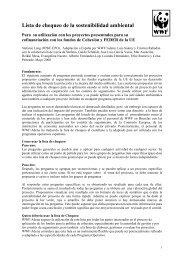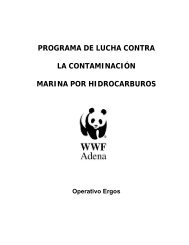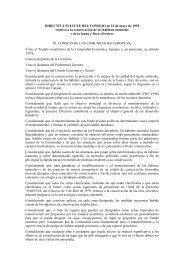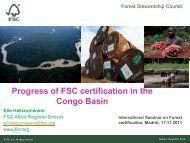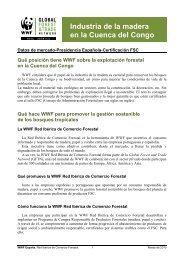RESUMEN EJECUTIVO - WWF
RESUMEN EJECUTIVO - WWF
RESUMEN EJECUTIVO - WWF
Create successful ePaper yourself
Turn your PDF publications into a flip-book with our unique Google optimized e-Paper software.
<strong>RESUMEN</strong> <strong>EJECUTIVO</strong><br />
La cuestión que plantea <strong>WWF</strong> surge a raíz de las catástrofes<br />
veraniegas que cada año protagonizan los grandes incendios<br />
forestales (GIF), aquellos en los que arden más de 500 hectáreas.<br />
A continuación exponemos los argumentos que conducen a <strong>WWF</strong> a plantear si en vez de recuperar<br />
bosques, lo que en realidad se está haciendo es “plantar” grandes incendios.<br />
PANORAMA<br />
DE LOS BOSQUES<br />
ESPAÑOLES<br />
España es el segundo país de la Unión Europea por superficie forestal después de Suecia, el<br />
primero de la ecorregión mediterránea y el tercero en superficie arbolada después de Suecia<br />
y Finlandia.<br />
Casi el 70% de los bosques españoles es de propiedad particular.<br />
Del total de la superficie forestal española, sólo el 13% cuenta con planes de gestión, la mayoría<br />
en terrenos públicos.<br />
La gestión forestal es competencia de las comunidades autónomas, aunque el Gobierno central<br />
es responsable de asegurar un objetivo común para la política forestal española.<br />
TENDENCIA<br />
DE LOS INCENDIOS<br />
EN ESPAÑA<br />
Se aprecia una tendencia a la baja en el número total de siniestros y en la superficie afectada<br />
por el fuego, pero en 2009 la mitad de las áreas afectadas lo fueron por un gran incendio.<br />
Ese mismo año se registraron 34 GIF sobre 15.391 siniestros, y aunque supone el 0,22% del<br />
número total, quemaron la mitad de la superficie que ardió en 2009.<br />
Los mecanismos de extinción han demostrado ser muy eficaces en los últimos años y de hecho<br />
en el 99,8% de los casos se consigue apagar los incendios antes de que alcancen las 500<br />
hectáreas. Precisamente los GIF se producen porque escapan a este control y por las propias<br />
características de su origen: un punto de ignición alejado de un acceso rápido y en condiciones<br />
meteorológicas extremas.<br />
RESPUESTA<br />
DE LAS<br />
ADMINISTRACIONES<br />
ANTE LOS INCENDIOS…<br />
En general, los responsables políticos marcan a golpe de catástrofe, a muy corto plazo, las<br />
urgencias de restauración, relegando a un segundo plano el desarrollo de una política forestal<br />
clara, estable y coordinada a nivel nacional.<br />
… Y SU<br />
PLANTEAMIENTO ANTE<br />
LAS REFORES-<br />
TACIONES<br />
Desde 1994 a 2007 se ha actuado sobre una superficie de 1,6 millones de hectáreas, de las<br />
cuales 0,7 millones lo han sido al amparo de la reforestación de tierras agrarias. Lamentablemente,<br />
durante ese mismo periodo, la superficie forestal afectada por el fuego ha sido de<br />
2,1 millones de hectáreas, de las cuales 0,8 millones eran arboladas. Además, estas actuaciones<br />
tienen grandes carencias en cuanto a la selección de especies, la priorización de las zonas<br />
de actuación o la coherencia con la planificación territorial.<br />
<strong>WWF</strong> España Incendios Forestales 2010 página 2
EN DEFINITIVA<br />
La escasez de planes de gestión forestal, la descoordinación entre las políticas forestales autonómicas<br />
y estatal, las carencias en la reforestación de tierras agrarias impulsada por la<br />
Política Agraria Común y la deficiente gestión e inversión en montes privados alimentan los<br />
grandes incendios del futuro.<br />
Además, en un escenario en el que el cambio climático adquiere cada vez más peso, la tendencia<br />
futura de los grandes incendios es preocupante. El incremento de días con condiciones<br />
meteorológicas extremas facilitará el desarrollo de los GIF.<br />
ALGUNAS<br />
PETICIONES<br />
DE <strong>WWF</strong><br />
<strong>WWF</strong> considera necesario luchar desde varios frentes para atajar los grandes incendios. Por<br />
ejemplo, con el decidido impulso a los planes de gestión forestal y con modelos mixtos de gestión<br />
públicos-privados o cooperativas de propietarios. El Gobierno central debe marcar unas<br />
pautas a nivel nacional de prevención de los GIF y un protocolo de actuación para restaurar<br />
las áreas arrasadas por los incendios. Esta política forestal se tiene que enmarcar a su vez en<br />
un escenario de compromisos más amplios que contemplen la reducción de gases de efecto<br />
invernadero en los sectores contaminantes y la adaptación al cambio climático.<br />
EN LOS ÚLTIMOS DIEZ AÑOS EL FUEGO HA RECORRIDO EN ESPAÑA<br />
UNA SUPERFICIE DE 1,2 MILLONES DE HECTÁREAS,<br />
UNA EXTENSIÓN MAYOR QUE LA DE LA COMUNIDAD FORAL DE NAVARRA.<br />
<strong>WWF</strong> España Incendios Forestales 2010 página 3
EXECUTIVE SUMMARY<br />
The issue raised by <strong>WWF</strong> stems from the summer disasters<br />
of big forest fires (BFF), those resulting in more than 500<br />
hectares burnt.<br />
These are the arguments that make <strong>WWF</strong> consider whether<br />
what is actually being done is “fuelling” fires instead of recovering forests.<br />
OVERVIEW<br />
OF SPANISH FORESTS<br />
Spain is the second country in the European Union in terms of forest surface, behind<br />
Sweden, the first in the Mediterranean Ecoregion and the third in terms of wooded surface,<br />
after Sweden and Finland.<br />
Almost 70% of Spanish forests are privately owned.<br />
Considering the whole Spanish forest area, only 13% has adequate management plans,<br />
mostly in public lands.<br />
Forest management is a competence of the autonomous regions, although the central<br />
Government is responsible for securing a common goal in Spanish forest policy.<br />
FIRE TRENDS<br />
IN SPAIN<br />
There is a downward trend in the total number of disasters and in the total area affected by<br />
fires, but in 2009 half of the affected areas were due to a big fire.<br />
That same year there were 34 BFF over 15,391 disasters, and although these represent 0.22<br />
per cent of the total numbers, those burnt half of the total surface affected in 2009.<br />
The mechanisms used to extinguish fires have proven to be very effective in recent years and<br />
in fact in 99.8 percent of the cases, they are successful putting out fires before they reach<br />
500 hectares. BFF occur precisely because they escape from this control and because they<br />
have special characteristics: an ignition point far from a quick access and extreme weather<br />
condition.<br />
THE RESPONSE<br />
OF THE<br />
ADMINISTRATIONS<br />
TO FIRES...<br />
In general, political representatives set the restoration urgencies in a very short term, just<br />
after a catastrophe, leaving behind the development of a clear, stable and coordinated<br />
forestry policy at national level.<br />
… ... AND THEIR<br />
APPROACH TO<br />
REFORES-<br />
TATION<br />
Between 1994 and 2007, actions have been carried out in an area of 1.6 million hectares, of<br />
which 0.7 million belong to the farmland reforestation programmes. Unfortunately, during<br />
this same period, the forest area affected by fires reached 2.1 million hectares, 0.8 million<br />
hectares of which were wooded areas. Furthermore, these actions lack major programs<br />
related to species selection, the prioritization of performance areas or territorial planning<br />
consistency.<br />
<strong>WWF</strong> España Incendios Forestales 2010 página 4
IN SHORT…<br />
The lack of forest management plans; the little coordination between the forest policy plans<br />
of the autonomous regions and those of the State; the gaps in reforestation of agrarian<br />
lands promoted by the Common Agricultural Policy; and the inadequate management and<br />
investment in private lands, are fuelling the big fires of the future.<br />
In addition, in a scenario in which climate change is becoming increasingly important, the<br />
future trend of big fires is a matter of great concern. The increase in days with extreme<br />
weather conditions will facilitate the development of BFF.<br />
<strong>WWF</strong><br />
REQUESTS<br />
<strong>WWF</strong> considers it is necessary to fight on all fronts to tackle big fires. For example,<br />
encouraging the forest management plans and mixed public-and-private management<br />
models or owners cooperatives. The Spanish Government must establish national rules<br />
to prevent BFF and an action protocol to restore the areas devastated by fires. This forest<br />
policy must be in turn framed in a context of wider commitments that include the reduction<br />
of greenhouse gases and climate change adaptation.<br />
FOR THE LAST TEN YEARS<br />
FIRES HAVE AFFECTED 1.2 MILLION HECTARES IN SPAIN,<br />
A LARGER SIZE THAN THE AUTONOMOUS REGION OF NAVARRA.<br />
<strong>WWF</strong> España Incendios Forestales 2010 página 5


